Lissa Johnston's Blog, page 22
April 19, 2016
Organic Opposition
 If you grow it, they will eat it or buy it
If you grow it, they will eat it or buy itin some form or fashion
whether they know it or notI'm currently working on a YA trilogy one could describe as Dystopia Lite. It takes place in a society that relies heavily on processed food (see what I did there?). Non-processed foodstuffs are illegal and are classified as controlled substances. It's an adventure/quest/conspiracy tale, very tongue-in-cheek, and I'm having a ball writing it.
Researching it has also been very enjoyable. Lord knows there's plenty of material out there. One of the most intriguing research threads has been about what I think of as The Rise of the Agricultural Machine, and why a huge percentage of what we consume, either to eat or to use, is made of corn or a corn product. But I digress.
The term 'organic' as it refers to food emerged in the counterculture era of the 1960s. It had been used earlier to encompass a feeling of more general opposition to the changes technology rained down on society during the Industrial Revolution in the early twentieth century.
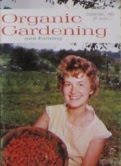 Health food guru J. I. Rodale was more directly responsible for using the word organic related to food cultivation. If you're familiar with the magazine Prevention, the surname Rodale may ring a bell for you. He championed the growth and consumption of what we now think of as organic food all the way back in the 1940s. Twenty years later, his teachings caught on with the hippies. Flower children co-opted the term and the philosophy, combining it with what they were trying to achieve living in communes. Today we would call that living off the grid. Theirs was a sort of back to nature movement with the additional goal of sticking it to the military-industrial complex.
Health food guru J. I. Rodale was more directly responsible for using the word organic related to food cultivation. If you're familiar with the magazine Prevention, the surname Rodale may ring a bell for you. He championed the growth and consumption of what we now think of as organic food all the way back in the 1940s. Twenty years later, his teachings caught on with the hippies. Flower children co-opted the term and the philosophy, combining it with what they were trying to achieve living in communes. Today we would call that living off the grid. Theirs was a sort of back to nature movement with the additional goal of sticking it to the military-industrial complex.One of the things I love about writing fiction is that while doing the research, I inevitably turn up stuff from real life that is way crazier than anything I could ever make up. For example: the notion that organic food was considered by some as something to be avoided in the 1960s and 1970s, like we avoid letting our mouths touch the spout on a water fountain. Big government and scientists in the pocket of Big Ag were very concerned that this new movement would erode their efforts in maximizing the industrialization of agriculture. They had spent a lot of money and scratched a lot of backs in Washington, D. C. to restructure government aid to farmers and reinvigorate foreign trade in commodities (mainly corn). They didn't want any disruptions and were probably mindful of the antiwar protests that had rattled the government bureaucracy and ended the Vietnam War. So they discredited the organic movement at every
opportunity:
- In 1974 a kangaroo court of food 'experts' convened a panel on 'The Food Supply and the Organic
Food Myth', branding the movement as 'dangerous nonsense'.
- Quoting from Michael J. Pollan's most excellent book The Omnivore's Dilemma:
 The bounty available at the Dallas Farmers Market
The bounty available at the Dallas Farmers Market"Henry J. Heinz, Jr. branded the organic movement 'food faddism', and he wrote that its advocates 'are persuading thousands to adopt foolish and costly eating habits'."
- and from the equally excellent Eat Your Heart Out by Jim Hightower, written contemporaneously (1975):
"Agriculture Secretary [Earl] Butz . . . became almost wild-eyed in his assertion that the specter of organic food production promises starvation for 50 million Americans."
Why all the panties in a twist over a micro movement that had little or no impact on the bottom line of the 1970s era food business? Because billions were being spent on marketing as well as production. Butz's Machiavellian machinations were restructuring farm subsidies as part of a grander scheme to change the way the agriculture sector worked. This new strategy depended on farmers flooding the supply of food to get the price to consumers down to absolute minimum. And BTW the consumers they were trying to please weren't you and me - they were mega corporations like Cargill and Archer Daniels Midland. The food biz was very mindful of the effects of the Vietnam War protests and how powerful the voting public could be if properly motivated. They didn't want a repeat wrecking the demand side if the organic food movement managed to generate a 'mistrust' of the food supply.
It is a great comfort to me, reading Hightower's book with forty years of perspective, that the organic movement has survived and indeed thrived since that time. There haven't been any food sit-ins or demonstrations or protests that I'm aware of. But people are voting with their pocketbook, and it's having an effect. Organic food still needs to overcome the stigma of being too pricey, too hipster-buying-kale. But the big food companies are taking pains to offer choices that appear to be healthier. Food co-ops and community gardens and farmer's markets are all the rage. If you're not sure that's true, take a look at the financials for Whole Foods, Earth Fare, and Trader Joe's. The wheel is turning slowly, but it is turning.
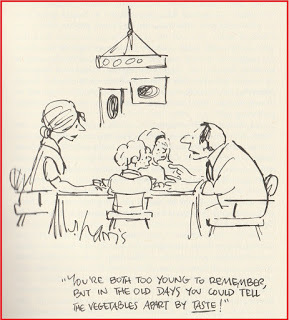 by Sidney Harris as seen in
by Sidney Harris as seen inEat Your Heart Out by Jim Hightower
Published on April 19, 2016 10:11
April 18, 2016
Neon Lights Up Our Nights
 Photo by Daxis on FlickrMy home town of Dallas, Texas was recently named the best skyline for 2016. I may be biased, but I agree. One of my favorite features is the Bank of America building with its stylish bright green outline. At the time it debuted in 1985 it was a bold choice, outlining the largest building in town in what one could describe, literally and accurately, as screaming neon. Many more buildings have sprung up over the last thirty-odd years, but it still easily holds its own with its distinctive signature color.
Photo by Daxis on FlickrMy home town of Dallas, Texas was recently named the best skyline for 2016. I may be biased, but I agree. One of my favorite features is the Bank of America building with its stylish bright green outline. At the time it debuted in 1985 it was a bold choice, outlining the largest building in town in what one could describe, literally and accurately, as screaming neon. Many more buildings have sprung up over the last thirty-odd years, but it still easily holds its own with its distinctive signature color.Technically speaking, the green glow resulted from argon gas, not neon. It was updated to LED technology in 2013, which gives the option of changing colors for special occasions.
The Bank of America building outline and others like it are the descendants of the original neon lighting. Neon gas was discovered in 1898. It was available in limited amounts until a Frenchman called Georges Claude figured out how to produce it in quantity. There are unverified reports that it was one of the wonders displayed at the 1904 World's Fair in St. Louis, which I discussed in a recent blog post. One of Claude's employees saw the potential for neon in the sign business. Red neon advertisements became all the rage in Paris and elsewhere.
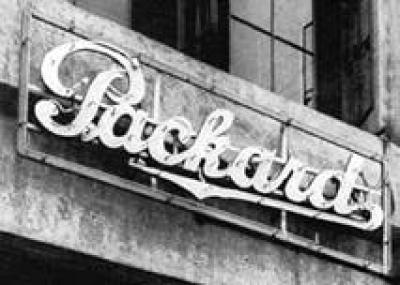 I won't pretend I have the mental chops to fully understand how neon signs work, but it appears to be a function of applying electricity to a glass tube that has been filled with gas. Originally, neon created a red glow. It is still used for red, orange, and some pink tones. Cooler colors like blues and greens are created using argon, mercury, and sometimes a special paint coating in the glass tubing.
I won't pretend I have the mental chops to fully understand how neon signs work, but it appears to be a function of applying electricity to a glass tube that has been filled with gas. Originally, neon created a red glow. It is still used for red, orange, and some pink tones. Cooler colors like blues and greens are created using argon, mercury, and sometimes a special paint coating in the glass tubing. America's first neon sign was initially thought to be commissioned by Earle C. Anthony for his Packard auto dealership at 10th and Hope streets in Los Angeles in 1923. Researchers have cast doubt on this claim, however. Regardless of its birth year, the Los Angeles sign definitely caused a stir, resulting in traffic jams as people marveled at the 'liquid fire'. Soon businesses nationwide were clamoring to install their own glowing letters.
Perhaps no city embraced the new colorful signage more fondly than Las Vegas. As the technology advanced, blinking and waving and diving and dancing signs populated the marketing landscape. Even if you're not into gambling, it's worth a visit to cruise The Strip and basque in its neon glow. While you're there, give a nod to the noble gas neon - lighting up our nights since 1898.
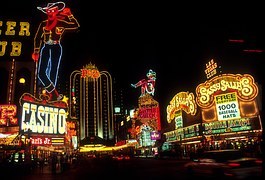 Las Vegas, where all good neon (and argon) goes to die
Las Vegas, where all good neon (and argon) goes to die
Published on April 18, 2016 19:02
April 15, 2016
The Mystery of the Melungeons
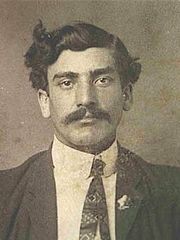
I'm more than halfway through the A to Z Blog Challenge and I must say it is magnificent for converting draft posts to published posts. Recently when I was feeling a little overwhelmed, I remembered I had some posts in draft. Ninety-five drafts, to be precise. I use the draft feature as a sort of index card when I have an idea for a blog topic. Some of the drafts, like yesterday's post on Lucretius, are fairly lengthy. Others, like today's post on the Melungeon people, are merely a single word to remind me of a topic I have found interesting in the past and would like to know more about.
Part of what drew me to this topic is the word itself. It looks intriguing, all those letters jumbled together in a unique way. And when you say it and hear it, it had a woven quality, meshing together very much like the ethnic origins of the people themselves.
The Melungeons are described by those who study such things as a 'tri-racial isolate'. They're a group of people of different ethnicities who have intensified their bloodline by not venturing far from where they were born and raised. Before I started my research, I tried to recall where they tend to be found. Part of me thought somewhere in America, but I had doubts because that unique moniker had me wondering if they were of a more exotic locale, like Bulgaria or Peru.
 I was right the first time. The Melungeons are typically found in Appalachia where eastern Tennessee and Kentucky border Western Virginia. The 'tri-racial' term comes into play because they are theorized to be a mix of African American, Native American, and European American. They tend to have dark hair (often straight), dark eyes, and swarthy skin.
I was right the first time. The Melungeons are typically found in Appalachia where eastern Tennessee and Kentucky border Western Virginia. The 'tri-racial' term comes into play because they are theorized to be a mix of African American, Native American, and European American. They tend to have dark hair (often straight), dark eyes, and swarthy skin.Not everyone agrees it is the African American and Native American cultures that are responsible for the Melungeons' darker physical features. Some suggest Portuguese, Black Dutch, Turks, Sephardic Jews, even Phoenician bloodlines may be responsible. Basically, if you were ever a sailor and may have shipwrecked on the Mid-Atlantic Coast in the 1600s, there is probably a Melungeon theory about you.
The simplest explanation is often the correct one, and the simplest is that early settlers who came to America as indentured servants, and therefore free people (as opposed to slaves), intermarried. Over time, their offspring became a challenge to identify precisely as one race or another. As time passed and laws shifted, claiming African American as your ethnic group became less attractive. When slavery became more widespread in the Mid-Atlantic and elsewhere, it was powerful motivation for those of mixed race to self-identify as something other than African (such as Native American or Portuguese). Other laws and cultural conventions contributed to this confusion.
In some cultures, children claim the ethnic group of their mother, regardless of what their father contributed to their DNA. So a child of a white mother and a non-white father would identify as white. Bureaucracy intervened in the 1700s for tax reasons, basically trying to close a loophole by insisting anyone of mixed race could no longer identify as Native American which left African American as the only other option. They got a higher tax rate on African Americans, you see. Flash forward one hundred years when slavery was going full blast, and they put the clamps on self-identifying by requiring you figure out some math to validate your ethnicity. Anyone who was less than 1/8 non-white was allowed to identify as white. In the 20th century, some states including Virginia espoused the 'one drop' rule, reversing the 1/8 standard by saying anyone with one drop of African American blood was considered African American.On top of all this, add laws that prevented marriage between different races. Mixed race peoples often intermarried to punitive measures. It was just easier.
The people now referred to as Melungeons did not come to be called so until around the1800s. The
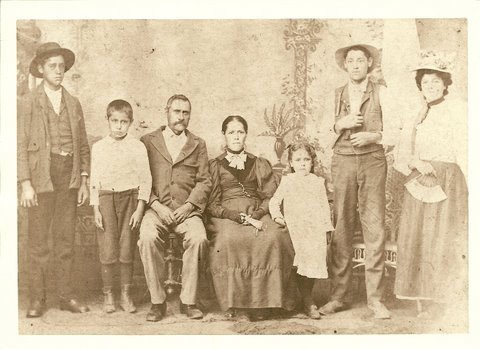 Members of the Goins familyword itself has some mixed etymology, which is only appropriate. The phrase mal engin appears in a 16th century poem, translating to 'ill intent'. But I like this other theory better: that it comes from the Angolan word malungu or malungo meaning companion, often used to refer to fellow shipmates and seen in Portuguese records. This theory meshes nicely with the colonization and melting pot image of early America and therefore is my favorite. Highly scientific.
Members of the Goins familyword itself has some mixed etymology, which is only appropriate. The phrase mal engin appears in a 16th century poem, translating to 'ill intent'. But I like this other theory better: that it comes from the Angolan word malungu or malungo meaning companion, often used to refer to fellow shipmates and seen in Portuguese records. This theory meshes nicely with the colonization and melting pot image of early America and therefore is my favorite. Highly scientific.The Melungeon culture is not something banished to a few posts online. They still exist in their corner of Appalachia. The surnames Gibson, Collins, Riddle, and others often can trace their lines to Melungeon origins. Family tree researchers generate many leads and interesting theories for your Googling pleasure. If you have relatives from that part of the country, you might have some Phoenician blood. Who knew?
Published on April 15, 2016 22:00
April 14, 2016
Lucking Onto Lucretius
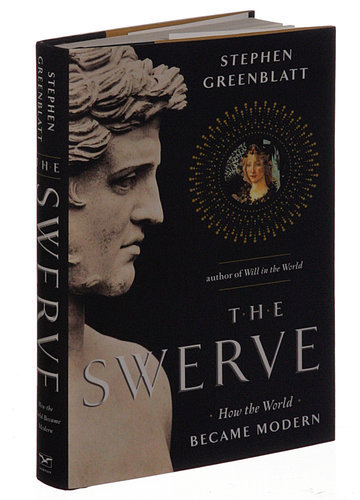 So I'm out to dinner with some friends I only see occasionally. These are friends from way back, the kind you spend most of your visit catching up on all the stuff you would already know if you saw each other more often. Toward the end of the evening, the topic turned to books. Conversational style changed from quiet chatting with those seated near you to a more organized, but less organic approach. And like that dreadful team-building activity where you pass the talking stick around the circle, my turn was soon coming.
So I'm out to dinner with some friends I only see occasionally. These are friends from way back, the kind you spend most of your visit catching up on all the stuff you would already know if you saw each other more often. Toward the end of the evening, the topic turned to books. Conversational style changed from quiet chatting with those seated near you to a more organized, but less organic approach. And like that dreadful team-building activity where you pass the talking stick around the circle, my turn was soon coming.I flashed back to times in elementary school when I was not only The New Kid but also Teacher's Pet with a side order of Nerd. All too often my attempts at contributing to a group conversation were met with blank looks and sniggers. What did you do this weekend? Kid #1: egged Charlotte Shrenk's brother's car, the pansy. Kid #2: Lifted a pack of gum from Skillern's. Kid #3: Looked through my uncle's stash of Playboy magazines. Me (too honest/naive to come up with a more exciting lie): Stayed up most of Saturday night to finish The Hobbit. Cue embarrassed silence and blank looks.
Then, as now, as the virtual stick approached, I was too slow coming up with an amusing line of BS, so I just went with the truth. I bungled the intro, already knowing this admission would be the turd in the punchbowl, the pin in our balloon of reminiscing revelry. "The Swerve by Stephen Greenblatt", I said, hoping against hope this book, unbeknownst to me, had made Oprah's Book Club, and it would be the darling topic of our dessert course. I was close. It did win the National Book Award for non-fiction in 2011. Strangely, this does not equate to Oprah's Book Club-like popularity. Cue blank looks. Strike one.
"It's a really cool book I first heard about on NPR." Cue eye glaze. Strike two.
"It's about the chance rediscovery of a previously lost ancient manuscript written by the Roman philosopher Lucretius, who basically ended up influencing all modern liberal thought as we know it." In that moment, I discovered that the killing of a buzz does indeed have a sound, and it is this: the sound of a great iron gate banging closed, ringing the ears as it fades to an ominous silence. Not a called strike, #3, oh no - it was a hundred mile-an-hour fastball luring the batter into a cartoonish 360° whiff, the kind that spins him so hard, the only thing keeping his tuckus from hitting the dirt is his quick hands using the bat as the third leg of his human tripod. Any notion that the Teacher's Pet/Nerd had shaken her grade school persona and become cooler, more worldly, sophisticated, even, in middle age, was immediately quashed by my nerd reading confession. Someone smiled thinly and said, "Sounds great!", and thankfully we lurched back into Conversation Lite.
But since this is, after all, my blog, and I can talk about whatever I want, I feel I owe it to Lucretius to spread the word about him. I have to admit the book was something of a grind. Sorry, Mr. Greenblatt! Having written some non-fiction, I know it is a challenge living up to the Laura Hillenbrand/Mary Roach gold standard of edutainment. The Swerve plodded along for the first half. But I was determined to finish what I had started, and I am so glad I did. When I finally got to the meat of the matter, Lucretius' own words laid out in black and white as they had originally begun thousands of years ago, my liberal heart soared.
He outlined the basic structure of the universe, proposing that all things were made up of tiny particles, infinite in number, combining and recombining, eternal in time and space. Pretty advanced, not to mention accurate, for someone who lived a thousand years before Galileo.His thoughts about these small particles and endless combinations led him to theorize Nature is constantly changing and experimenting and yes, evolving. Sound familiar?He had some incendiary thoughts about organized religion as well (thought it was bunk). Some describe him as an atheist, but he was more of a deist. He never said god(s) didn't exist. He just didn't think they gave two hoots about what we puny humans were up to.He talked about sex (it's a really long work), including a passage W. B Yeats called 'the finest description of sexual intercourse ever written'. If that's not enough to encourage you to check out Swerve or The Nature of Things, I give up.
 Spiral galaxy via Hubble telescopeMy favorite passages are more philosophical. He may be the founder of today's minimalism movement, for he believed life's goals are simple: seek pleasure, avoid pain. But there are boundaries, and failing to recognize them leads to acquisition and excess, which spoils everything.
Spiral galaxy via Hubble telescopeMy favorite passages are more philosophical. He may be the founder of today's minimalism movement, for he believed life's goals are simple: seek pleasure, avoid pain. But there are boundaries, and failing to recognize them leads to acquisition and excess, which spoils everything.He believed in something Greenblatt calls a 'swerve'. Call it serendipity, or happenstance, or the butterfly effect. Lucretius applied this concept at the molecular level and beyond, proposing these minute and random changes often produce the most remarkable results.
It would be silly to generate an over-long blog post about Lucretius without actually quoting the guy. Here's a passage Greenblatt admired. I've experienced this feeling a couple of times. If you've ever volunteered to be the Designated Driver, you've probably experienced it, too:
"It is comforting, when winds are whipping up the waters of the vast sea, to watch from land the severe trials of another person: not that anyone's distress is a cause of agreeable pleasure; but it is comforting to see from what troubles you yourself are exempt. It is comforting also to witness mighty clashes of warriors embattled on the plains, when you have no share in the danger. But nothing is more blissful than to occupy the heights effectively fortified by the teaching of the wise, tranquil sanctuaries from which you can look down upon others and see them wandering everywhere in their random search for the way of life, competing for intellectual eminence, disputing about rank, and striving nigh and day with prodigious effort to scale the summit of wealth and to secure power."
Lucretius wasn't satisfied with defying convention and authority and being right about just about everything. Oh no. He had to write it all in verse. As a poem. In Latin, natch. (drops mike) Why on earth go to all this trouble? It was hard enough noodling around the concepts that drive society (or should) as well as our universe. Lucretius said he considered presenting his ideas as poetry "honey smeared around the lip of a cup containing medicine that a sick child might otherwise refuse to drink" (Greenblatt quote, not Lucretius). So basically, if he were around today, he would frame his work as an indie film or a rap song or a Banksy-style graffiti.
Lucretius' poem The Nature of Things lay undiscovered for a thousand years until a papal staffer
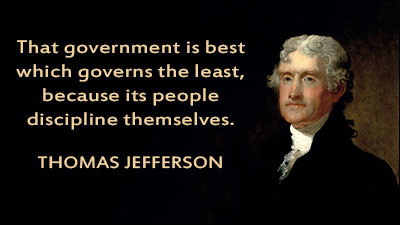 My favorite Founding Fathernamed Poggio chanced upon it in 1417. Once recovered, copies were made, at first by hand, then by press post-Gutenberg. Ripples of its influence spread from Florence outward. With the advantage of hindsight, one can see his impact on intellectual giants more familiar to us, including Galileo, da Vinci, Newton, Darwin, a couple of Thomases (More and Jefferson), and even Shakespeare. One wonders what things might be like if Poggio had overlooked a crumbling manuscript in a musty library so long ago. It delights me no end that he didn't, and that it came to light again because of a swerve.
My favorite Founding Fathernamed Poggio chanced upon it in 1417. Once recovered, copies were made, at first by hand, then by press post-Gutenberg. Ripples of its influence spread from Florence outward. With the advantage of hindsight, one can see his impact on intellectual giants more familiar to us, including Galileo, da Vinci, Newton, Darwin, a couple of Thomases (More and Jefferson), and even Shakespeare. One wonders what things might be like if Poggio had overlooked a crumbling manuscript in a musty library so long ago. It delights me no end that he didn't, and that it came to light again because of a swerve.
Published on April 14, 2016 08:26
April 13, 2016
Krewe Konfessions
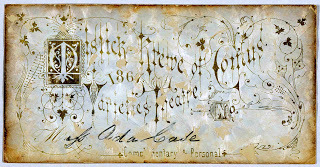 Mystick Krewe of Comus invitations
Mystick Krewe of Comus invitationsnotoriously hard to come byLook at this beauty: an invitation to the Mystick Krewe of Comus' 1867 Mardi Gras ball. Most are familiar with the springtime New Orleans extravaganza. But what's up with the krewe business?
First, let's clarify what's going on with the word 'krewe'. It's pronounced the same as 'crew', but the founders thought it would be fun to give a shout-out to John Milton and spell it old-style. Krewes are basically private clubs. Membership is select and usually requires a fee. Some membership rosters are secret. The fee varies widely, from a few bucks to thousands. Think country club membership, without the golf. Their purpose is to make a splashy contribution to the Mardi Gras celebration. This usually takes the form of an elaborate parade float with all the accoutrements (costumes; items like fake coins and cheap beads to throw to the crowd). Some also throw a big party on Mardi Gras night, from lavish balls to tailgate-style cookouts.
 The theme for Comus Krewe's floats in 1867:
The theme for Comus Krewe's floats in 1867:EpicureanThe Comus Krewe is the oldest New Orleans krewe, founded in 1857.The founders were familiar with the long tradition of elaborate Mardi Gras celebrations in Mobile, Alabama, which began in 1703. Yes, that's right - Mobile is the birthplace of the Mardi Gras celebration as we know it, not New Orleans. Not to be outdone by their Gulf Coast neighbors to the east, the Comus Krewe put on quite the shindig at home in New Orleans that spring. It was a big hit. Word got around. In subsequent years, folks traveled from near and far to observe the annual New Orleans parade. And thus a multi-million dollar tourist industry was born.
Like some country clubs, membership in Comus was limited and pricey. It wasn't long before other krewes sprang up to fill the void created by their snootiness. Some were copycats, equally pricey and snooty. Some were more casual, catering to underserved (read: folks Comus wouldn't allow in their club, like non-whites, non-Protestants, non-men).
Comus Krewe operations flowed more or less without interruption until they hit a bump in the parade route in 1992, when New Orleans passed an anti-discrimination law. Comus chose to withdraw from parade participation rather than comply with the new law as it applied to their membership. They still hold their annual ball.
Most of what you've read here is more or less verified and accurate, as accurate as anything can be that is based on online research. This last bit is to be viewed with an exceedingly skeptical eye, but it was so outrageous and, dare I say, crazy, I had to share.
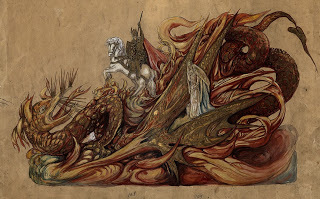 Flights of Fancy
Flights of Fancy1901 Mardi Gras parade float designed for Comus Krewe
by Jenny Wilde, one of the first female float designers
via Tulane University LibraryDiligent Googling about the Comus Krewe may also steer you to a website claiming to be a transcription of a deathbed confession by a former member. In it, he claims the krewe was a front for a secret society composed of anarchists, murderers, and (gasp!) Yankee bankers. The argument is made that certain founders of the Krewe had ties to powerful financial interests that supported the creation of the Confederacy, and therefore were behind all manner of mayhem to bring this to pass. It makes all kinds of claims connecting Comus Krewe to the Bank of Rothschild, the Illuminati, the Masons, the assassination and attempted assassination of various high ranking politicians, including James Buchanan, Zachary Taylor, William Henry Harrison (presidents all) and longtime Louisiana politician Huey P. Long. The confessor does say most krewe members were unaware of the diabolical deeds the ringleaders orchestrated.
The article is long, as conspiracy rants tend to be. It needs a good editor. It's probably a load of nonsense. But if you're a conspiracy theorist, or you're looking for some story ideas, check it out. The Comus Krewe confessions might lead you somewhere even more entertaining than the French Quarter during Mardi Gras.
Published on April 13, 2016 06:29
April 12, 2016
Jobs Rule The Migration Roost
 Working on the SS George Washington Carver in
Working on the SS George Washington Carver ina shipyard in CaliforniaAsk around wherever you live, and I'll bet you'll find more folks 'not from around here' than locals. And I'll also bet the reason they're Here rather than There is simple: Jobs.
Humans have been migrating to improve their prospects since Ice Age hunters crossed the Bering Strait. When I was researching my latest book, I studied immigration patterns of Norwegians to America. It's mind-boggling how many people risked everything for a chance to provide a better situation for themselves and their family. They may not have looked at it as moving for a job opportunity, but that's basically what they were doing.
Migration (as opposed to immigration) patterns are slightly different in that they occur within a country's borders. Just because you don't feel the need to change countries doesn't mean you won't be packing a bag to follow a job. Ask anyone in the armed services. Or at FedEx, which is how our family came to live in seven different cities (and six states) in eighteen years. These migration patterns are equally fascinating to me, perhaps because I have a personal connection.
One of my favorite family tales involves the World War II era. My dad and his brother were born in a small rural town east of Dallas, Texas. They came from a long line of farmers, since those first Norwegian ancestors came to Texas in the 1850s. But the times, they were a-changin'. During the war, manufacturing boomed. Strict immigration laws enacted in the 1920s shut off the supply of foreign labor. Factories couldn't find workers fast enough. When war came and stimulated the manufacturing sector, many jobs were available for workers already living in America, regardless of race or gender. The American work force increased dramatically as rural workers and women joined the ranks.
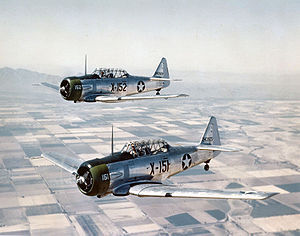 The T6-Texan Trainer manufactured by the
The T6-Texan Trainer manufactured by theNorth American plant in the Dallas areaMy paternal grandfather was among the first group. He went to work at the 'bomber plant', aka North American, later known as Ling Tempco Vought or LTV, in the Dallas area. Housing was scarce in the city. At first, he went alone and came home on the weekends. Eventually a room in town became available. Not a house. A room. So my grandmother was able to join him. There was only one problem. They had two sons, and the landlord would only allow one more person to occupy the lease. The decision was made: my dad's younger brother was to go to the big city with his folks. My dad would be left behind with his grandparents on the family farm. (Cue the sad violin music here.) As my dad was telling me this story, I tried to be brave, but I fear I may have experienced some eye sweat. I told him I thought this was one of the saddest things I ever heard. He said, "Why? I loved the farm. It was my home. My granddad spoiled me rotten. I was sad when I eventually had to move to the city with my folks." Shows what I know.
I grew up vaguely aware that my paternal grandfather worked in the war effort. It was only recently as my mom was telling me some of her family lore that I learned her father also came from their farm in rural Texas to work at the bomber plant. The same plant. (You may be wondering: did everyone work at this plant? Actually, yes.) In both cases, the families ended up relocating to Dallas permanently, leaving farm life behind. And if not for this, my parents likely never would have met, and that would have been exceedingly bad luck for me.
My grandfathers didn't have far to migrate for their defense industry jobs, but many others did. Around four million people migrated to a war-related job in the World War II era and afterward. They often moved long distances, even cross-country. There wasn't a bomber plant or shipyard on every corner. They tended to be in northern cities or on the West Coast.
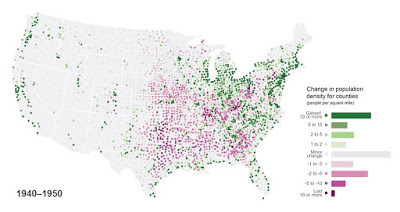 The green indicates increase in population; the purple, decrease
The green indicates increase in population; the purple, decreasemap from census.govMigration was a societal force within the African American community in particular. They made up about a third of the migration figures quoted above. In 1940, an estimate 45% of African Americans worked on farms. By 1980, that number had shrunk to 1%. Many saw the war industry as an opportunity to escape lower status jobs as well as the Jim Crow segregation laws that dominated areas of the South at that time.
The tides turned again later in the 20th century when lower cost of living, fewer labor unions, and better weather enticed many companies to relocate their operations back into the South. I never met a Yankee or ate a bagel until some time in the 1980s. Now, they're everywhere (including in my house - my husband is from Philadelphia).
I'm very curious to see what the next job migration wave will be, if any. So many people work remotely these days. The next iteration may be greatly simplified. Instead of predicting which part of the country will see an influx of workers, it may just be a matter of determining which room in the house works best as a home office.
 My current job location
My current job location
Published on April 12, 2016 12:05
April 9, 2016
International Flair at the World's Fair
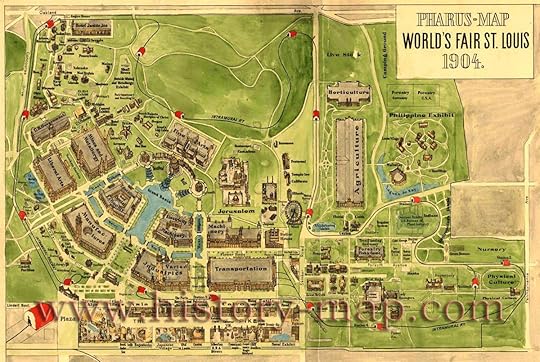 I was doing some research about the 1904 World's Fair recently, which got me to wondering: whatever happened to the World's Fairs? All kinds of cool things went on at the 1904 Worlds Fair in St. Louis, the coolest of which perhaps was the introduction of ice cream served in cones. Thanks to Syrian immigrant Ernest Hamwi, we can enjoy the sweet creaminess without lapping it out of a bowl like my yellow Lab used to do. Two other personal favorites made an appearance there. Hamburgers were introduced to the world by a fellow known as Uncle Fletch, the owner of a small cafe in Athens, Texas. Now it all makes sense why, as a Native Texan, I can't quit my cheeseburger habit. Curse you, Whataburger! Oh - and the other thing going on at the fair (as if ice cream and hamburgers weren't enough): just a little something we like to call the Olympics. According to Wiki, this was the first Olympics held in a predominantly English-speaking country, as well as the first held outside of Europe. I'm guessing the event planner profession also made its debut here.
I was doing some research about the 1904 World's Fair recently, which got me to wondering: whatever happened to the World's Fairs? All kinds of cool things went on at the 1904 Worlds Fair in St. Louis, the coolest of which perhaps was the introduction of ice cream served in cones. Thanks to Syrian immigrant Ernest Hamwi, we can enjoy the sweet creaminess without lapping it out of a bowl like my yellow Lab used to do. Two other personal favorites made an appearance there. Hamburgers were introduced to the world by a fellow known as Uncle Fletch, the owner of a small cafe in Athens, Texas. Now it all makes sense why, as a Native Texan, I can't quit my cheeseburger habit. Curse you, Whataburger! Oh - and the other thing going on at the fair (as if ice cream and hamburgers weren't enough): just a little something we like to call the Olympics. According to Wiki, this was the first Olympics held in a predominantly English-speaking country, as well as the first held outside of Europe. I'm guessing the event planner profession also made its debut here.Admission to the 1904 World's Fair cost fifty cents for adults and a nickel for kids. In 2016 money that works out to around $12.50 for an adult and around a buck and a quarter for kids.
 But where is the flashlight app?World's Fairs began, as all cool things do, in France. The first one was held in 1844. The idea was to showcase interesting, innovative products and inventions and entertainment and activities from a variety of countries. It's as if South by Southwest and the Consumer Electronics Show had an international baby. The fairs earned a reputation for introducing incredible technological advances to the world, such as the telephone, the electrical outlet (making electricity easily available to the general public), the diesel engine, the x-ray machine, and touch screen technology.
But where is the flashlight app?World's Fairs began, as all cool things do, in France. The first one was held in 1844. The idea was to showcase interesting, innovative products and inventions and entertainment and activities from a variety of countries. It's as if South by Southwest and the Consumer Electronics Show had an international baby. The fairs earned a reputation for introducing incredible technological advances to the world, such as the telephone, the electrical outlet (making electricity easily available to the general public), the diesel engine, the x-ray machine, and touch screen technology.The fairs have been held in a variety of locations, which makes sense, considering its billing as an international event. U.S. cities have hosted them a dozen or more times since the first one in Philadelphia in 1876. The fairs are similar to the Olympics in that they are organized by a governing body; countries bid to have them; they are held to a certain schedule (every five years sincd 1995); and cost a bundle to put on. Unlike the Olympics, World's Fairs tend to linger from weeks to months, presumably to bring in as much attendance as possible and try to make their money back.
 The observation towers and pavilion of the 1964
The observation towers and pavilion of the 1964New York City World's Fair in their heyday
Spend an afternoon researching fairs and they will all start to run together. But a few stand out in my mind:
1893 Chicago - loads of innovative stuff debuted here, including the world's first Ferris wheel. But they will forever be eclipsed in my mind because the fair was the inspiration for Eric Larsen's terrifyingly non-fiction Devil in the White City , about a serial killer who ran amok at the same time the fair was going on.1962 Seattle - I didn't realize the iconic Space Needle was a holdover from a World's Fair. I feel like I should've known that. I've never visited Seattle. It's on the bucket list. 1964 New York City - speaking of architecture, the observation towers made famous in the original Men In Black movie are not faring too well and are considered 'ruins'. But the Unisphere still stands. I saw it when were attending the U. S. Open a few years ago.
The last fair in the U.S. was held in New Orleans in 1984, and none are scheduled here through 2020. I guess we'll just have to be satisfied with CES and SXSW.
Published on April 09, 2016 14:02
April 8, 2016
Thanks To Hamilton, History is HOT
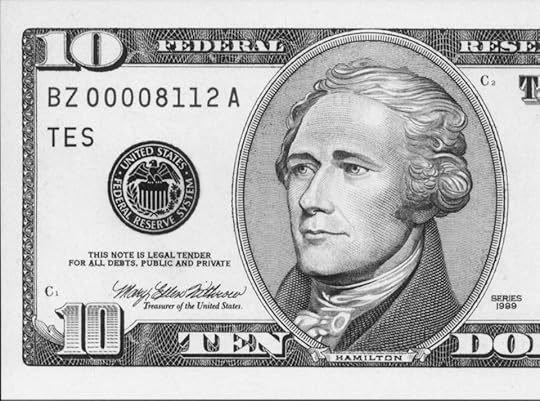 As a certified History Nerd, I'm beside myself with glee that the current number one Broadway hit is about one of our nation's founding fathers. But here's the thing: it's not anyone most people remember from grade school history class. Not Washington. Not Jefferson. Not Lincoln (and how many of you would have stopped me there, because you know Lincoln was great but doesn't qualify as a Founding Father?). Let's face it: between teaching-to-the-test public education policy and fading Baby Boomer memory, who of us can be expected to remember that stuff anyway (if in fact we ever knew it to begin with)? So this is why I'm so amazed at this phenomenon: A show about someone hardly anyone remembers is killing it on Broadway. Alexander Hamilton never made it to the top job (President). Sure, he's on the money, but I think they just threw him that bone for being the nation's first Secretary of the Treasury.
As a certified History Nerd, I'm beside myself with glee that the current number one Broadway hit is about one of our nation's founding fathers. But here's the thing: it's not anyone most people remember from grade school history class. Not Washington. Not Jefferson. Not Lincoln (and how many of you would have stopped me there, because you know Lincoln was great but doesn't qualify as a Founding Father?). Let's face it: between teaching-to-the-test public education policy and fading Baby Boomer memory, who of us can be expected to remember that stuff anyway (if in fact we ever knew it to begin with)? So this is why I'm so amazed at this phenomenon: A show about someone hardly anyone remembers is killing it on Broadway. Alexander Hamilton never made it to the top job (President). Sure, he's on the money, but I think they just threw him that bone for being the nation's first Secretary of the Treasury.Let's digress for a moment: Hamilton is currently on the $10 bill, which is nicknamed a 'sawbuck'. I say currently, because he's also been on the $2 (yes, we still have one and they're so fun - go get some next time you're at the bank), the $5, the $20, the $50, and the $1000. It tells you something about me that I love the cute little $2 bill, but I didn't even know we had a $1000. That's what I get for not going into the drug dealing biz. Hamilton's time on the $10 may also be numbered - there's talk of kicking him off it in favor of a woman. Back to the sawbuck: It's called that for a somewhat convoluted reason, but interesting nonetheless. Sawbuck is from the Dutch word for the common construction tool often called a sawhorse. The early models were more X shaped. That way, they could easily be used for sawing up logs. And of course X being the Roman numeral for 10, if 'sawbuck' = X and X = 10, therefore 'sawbuck' = 10. And there's the extent of my high school algebra knowledge.

Hamilton is not the only pop culture history juggernaut. Turn is a recent television series featuring George Washington's Revolutionary War spy network. Mercy Street is about volunteer nurses during the Civil War. Texas Rising, about a few pivotal days during the Texas Revolution, aired with success last spring. Underground, Vikings, Spartacus, The Last Kingdom, Boardwalk Empire, Downton Abbey, even Drunk History are earning millions of views from across a very broad demographic. So let this be a (history) lesson for all of us writers: there's plenty of material out there, and we don't even have to make anything up. As the man said, this stuff writes itself.
Published on April 08, 2016 11:00
The Goodreads Revelation
Like many writers, the lion's share of my marketing efforts is directed at Facebook and Twitter. But the focal point of my recent engagement efforts has added a third leg to the marketing stool: Goodreads. It's not as if I've mastered the other two - I certainly haven't. But when another writer friend mentioned I hadn't set up an author presence on GR (thanks, Matt!), I did some checking and realized I was overlooking an important piece of the marketing puzzle.

As an avid reader, I've been enjoying Goodreads for years. It's a great way to organize reading lists and find book recommendations. Turns out it's also a great way to network with other readers. More readers mean more reviews. More reviews (even if they're not five stars) are better than no reviews.
In the process of setting up my author presence there, I discovered I had never invited my Facebook and Twitter friends to befriend me on Goodreads as well. This was a simple click that grew my GR friends from 60 or so to 350+ and counting. Investigating some of these new GR friends' profiles, reaching out via GR's email function, and joining special interest groups has already led me to some wonderfully generous authors who have shared some great tips with me, like Susan May. Thanks to her cogent explanation of how and why to use Goodreads, I am committed to making GR an equal partner in my social networking efforts.
By now I hope I've convinced you to include Goodreads in your engagement strategy. How much time, you may be wondering? On a recent day, this is how I spent the time I apportioned to marketing/platform:
I selected a page of Goodreads friends, around 30 names or so.I clicked on each name to view their profile. I reached out via GR and introduced myself. If they had written any books, I selected at least one as Want To Read. I noted their Twitter handle and made sure I was following them. Ditto their Facebook page. If they had a website, I visited it. If they had a blog, I read a few posts and commented if I had something relevant to say. I subscribed to their website. I shared any posts I thought fit into my platform.
This cost me nothing in actual dollars and cents, and took about one hour of my time. With over 300 friends on Goodreads, working through one page of friends per day, I estimate I will complete this project in about two weeks. Once I'm caught up, I hope to stay current as I add friends rather than doing them in batches.
If there are any programs or apps out there that will show me the social media info of people I already follow on Goodreads or Facebook or Twitter, please let me know what they are. I know you can invite FB and Twitter friends to GR, but I don't know of any way to do the reverse other than manually.
Let me digress (and it just wouldn't be one of my blog posts if I didn't digress, now would it??) and thank all of you who place your social networking gadgets in a prominent place near the top of your website. Hunting and gathering for links is the number one time waster in this whole platform/engagement endeavor. I can't tell you how many times I had to go searching manually for authors' Facebook pages because there was no indication on their website they the had ever heard of FB, much less set up a page there. But when I clicked over to Facebook on my own, just to double check, and typed in the author's name in the FB search bar, lo and behold! There was a perfectly nice FB page, all up to date with current posts and lots of likes and everything, just waiting to be discovered. People, for the love of all that is holy, please keep your websites updated with live links. If I hadn't been in OCD mode, bound and determined to track them down, I would have done the BOTH and zoomed on to the next author's site. That is all.
Being engaged is a good feeling. Human interaction can be a lot of work, but also very gratifying. I'm enjoying working with Goodreads. It's a nice change of pace from FB and Twitter, which, let's face it, can be something of a cricket echo chamber. And here's the requisite CTA: I hope you will take a minute and follow me on Goodreads. I follow back

As an avid reader, I've been enjoying Goodreads for years. It's a great way to organize reading lists and find book recommendations. Turns out it's also a great way to network with other readers. More readers mean more reviews. More reviews (even if they're not five stars) are better than no reviews.
In the process of setting up my author presence there, I discovered I had never invited my Facebook and Twitter friends to befriend me on Goodreads as well. This was a simple click that grew my GR friends from 60 or so to 350+ and counting. Investigating some of these new GR friends' profiles, reaching out via GR's email function, and joining special interest groups has already led me to some wonderfully generous authors who have shared some great tips with me, like Susan May. Thanks to her cogent explanation of how and why to use Goodreads, I am committed to making GR an equal partner in my social networking efforts.
By now I hope I've convinced you to include Goodreads in your engagement strategy. How much time, you may be wondering? On a recent day, this is how I spent the time I apportioned to marketing/platform:
I selected a page of Goodreads friends, around 30 names or so.I clicked on each name to view their profile. I reached out via GR and introduced myself. If they had written any books, I selected at least one as Want To Read. I noted their Twitter handle and made sure I was following them. Ditto their Facebook page. If they had a website, I visited it. If they had a blog, I read a few posts and commented if I had something relevant to say. I subscribed to their website. I shared any posts I thought fit into my platform.
This cost me nothing in actual dollars and cents, and took about one hour of my time. With over 300 friends on Goodreads, working through one page of friends per day, I estimate I will complete this project in about two weeks. Once I'm caught up, I hope to stay current as I add friends rather than doing them in batches.
If there are any programs or apps out there that will show me the social media info of people I already follow on Goodreads or Facebook or Twitter, please let me know what they are. I know you can invite FB and Twitter friends to GR, but I don't know of any way to do the reverse other than manually.
Let me digress (and it just wouldn't be one of my blog posts if I didn't digress, now would it??) and thank all of you who place your social networking gadgets in a prominent place near the top of your website. Hunting and gathering for links is the number one time waster in this whole platform/engagement endeavor. I can't tell you how many times I had to go searching manually for authors' Facebook pages because there was no indication on their website they the had ever heard of FB, much less set up a page there. But when I clicked over to Facebook on my own, just to double check, and typed in the author's name in the FB search bar, lo and behold! There was a perfectly nice FB page, all up to date with current posts and lots of likes and everything, just waiting to be discovered. People, for the love of all that is holy, please keep your websites updated with live links. If I hadn't been in OCD mode, bound and determined to track them down, I would have done the BOTH and zoomed on to the next author's site. That is all.
Being engaged is a good feeling. Human interaction can be a lot of work, but also very gratifying. I'm enjoying working with Goodreads. It's a nice change of pace from FB and Twitter, which, let's face it, can be something of a cricket echo chamber. And here's the requisite CTA: I hope you will take a minute and follow me on Goodreads. I follow back
Published on April 08, 2016 09:45
April 6, 2016
Fowl Foils French Fleet

Folks, if you haven't discovered the New York Public Library's Digital Collection yet, what're you waiting for? It's great for history buffs, writers, and knowledge-seekers of any stripe. If you're looking for an informative, entertaining rabbit hole that easily qualifies as productive procrastination, NYPL is the place to be.
To wit: today as I was casting about for a blog topic to satisfy today's A to Z Challenge 'F' requirement, I discovered this little gem tucked away in one of their cigarette card collections. (Apparently cigarette cards were the early 20th century version of Pokemon, with nerdier topics and better art.) It introduced me to the term 'Cock of the Fleet', indicating which ship is considered the best within its group (or 'fleet' in naval terms).
Before anyone gets their feathers ruffled by this fowl terminology, let me assure you, spending only a little amount of time in South Carolina will dull your delicate sensitivities to this term being so freely bandied about. I admit I was a little shocked the first time I was grocery shopping at Harris Teeter after we moved to SC and saw a young man wearing a shirt that read COCKS. All in caps. Just like that, right across his chest. I had to come home, fan myself, and Google. Turns out it's an homage to the state university's mascot (the Gamecocks), not an analog version of Tinder. Oh and hey BTW one more little nugget I stumbled across: South Carolina's mascot is unique among the major athletic programs in the country. When you say you cheer for the Gamecocks, nobody says 'which ones?'. Take that, Tigers!
But I digress. Cock of the Fleet, or COTF as it's sometimes known, is a proud Royal Navy tradition.
 The crew of HMS Ulster celebrating a COTF win ca 1969Ships' crews compete in navy-related athletic activities, primarily rowing races. Betting is allowed, further enhancing the competitive spirit. The winners are awarded with a trophy or plaque, which they proudly display on board.
The crew of HMS Ulster celebrating a COTF win ca 1969Ships' crews compete in navy-related athletic activities, primarily rowing races. Betting is allowed, further enhancing the competitive spirit. The winners are awarded with a trophy or plaque, which they proudly display on board.As the informative little cigarette card tells us, this tradition got its name because of a bizarre incident during the Battle of the Saintes in 1782 during the American Revolution. As part of the larger goal to assist the Americans in their defeat of the hated British, the French navy hatched a plan to take over Jamaica while they were at it. During the battle, the British ship HMS Formidable was struck by fire from a French ship , making a big fat mess of things on board. One of the crates carrying poultry became, unsecured, shall we say, and a rooster escaped. He spent the rest of the battle perched on the rail of the poop deck (and maybe that's why they call it that now), crowing his little heart out, cheering on his crew. Can you imagine? Death and destruction all about, your life flashing before your eyes as you imagine a forthcoming trip to Davy Jones' locker, and suddenly out of nowhere this rooster appears and starts crowing to beat the band. If I had been there that day, dodging cannon fire and wishing I had paid more attention during swim lessons, I think I would have had to laugh - that crazy hysterical laugh you can't control when something hilarious happens in the middle of something awful.
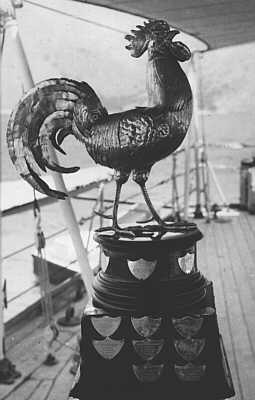 COTF Trophy on board HMS Gambia
COTF Trophy on board HMS Gambiaca 1952Maybe it was due to the crowing; maybe due to the British Navy's top secret new battle strategy known as 'breaking the line'. For whatever reason, the Royal Navy prevailed. Their victory had little effect on the American Revolution, but it did keep Jamaica out of French hands.
When the British Admiral heard about this cock tale, he granted a permanent stay of execution for the plucky rooster who cheered his crew to victory. A happy ending for our fine feathered friend, and who knows, perhaps the ancestor of an equally fine fowl found on a football field most fall Saturdays in Columbia, SC.
Cigarette card at beginning of post from George Arents Collection, The New York Public Library. ""The cock of the fleet."" The New York Public Library Digital Collections. 1938.
Published on April 06, 2016 13:52



